Green stormwater infrastructure-GSI-Informed Urban Groundwater Monitoring Networks
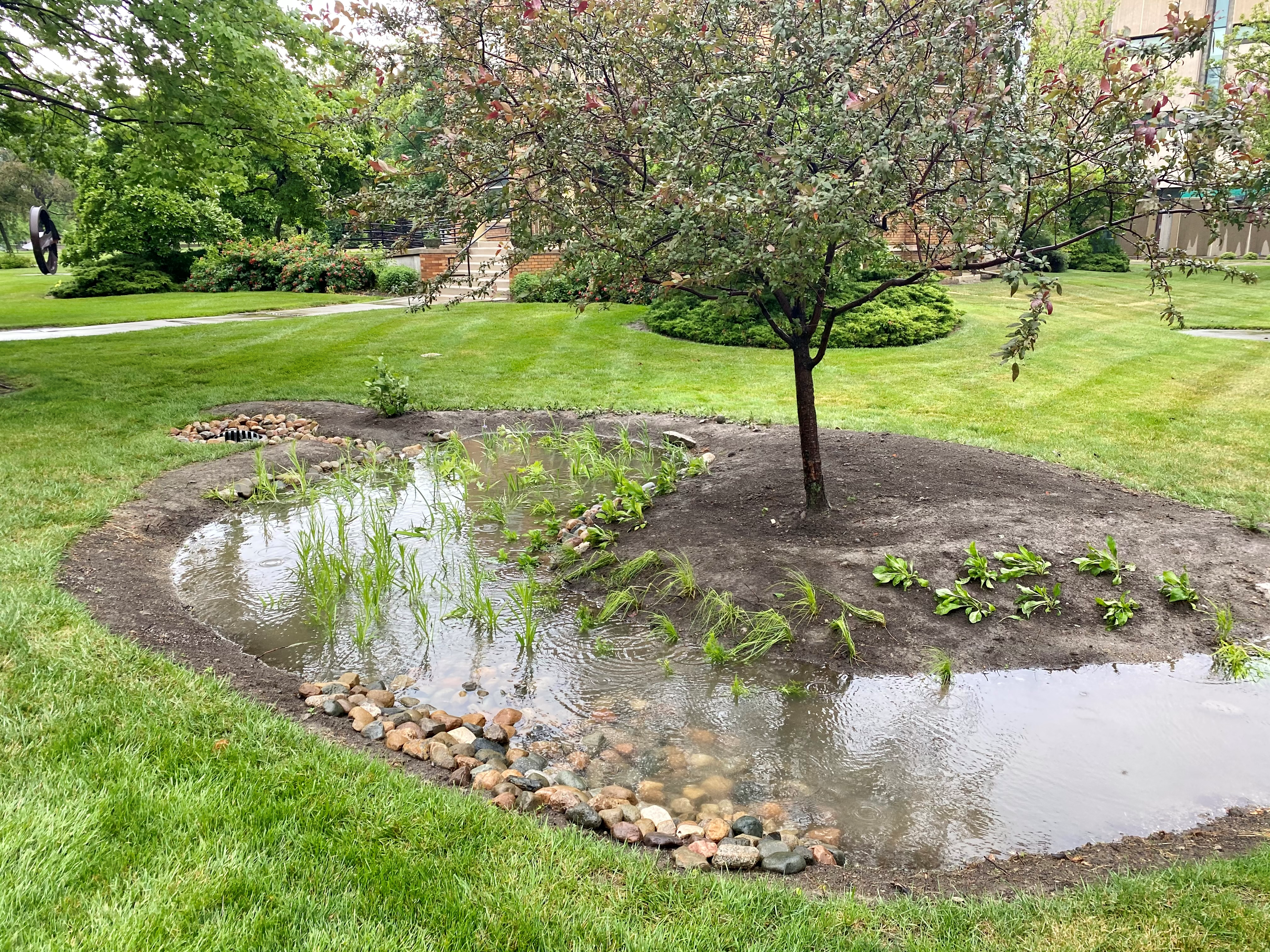
EPA Grant Number: SU840160
Title: Green stormwater infrastructure-GSI-Informed Urban Groundwater Monitoring Networks
Investigators: O'Leary, Brendan; Miller, Carol; Mitra, Rahul; Kashian, Donna; Dabney, Brittanie; Ekhator, Kate; Hatrick, James; Kakaris, Dimitrious; LaCroix, Ashley; Linn, Colleen; Lyon, Natalie; Pruett, Adam; Serreyn, Michelle; Shahin, Kamjou, Amir; Steis Thorsby, Jamie; Teimoori, Sadaf
Institution: Wayne State University
Research Category: P3 Awards , P3 Challenge Area - Safe and Sustainable Water Resources
Project Period: December 1, 2020 through November 30, 2021
Manuscript in development
1. Background and problem definition
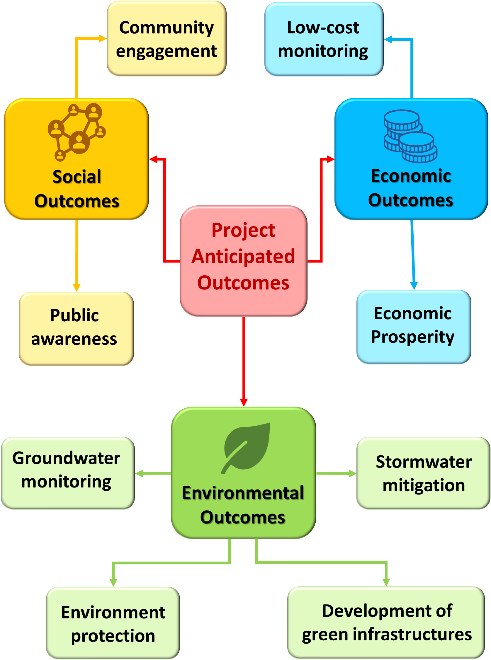
Water is a critical resource in urban areas, but it can be difficult to characterize given the high degree of hydraulic modifications in urban settings (Bach et al., 2014). Over time, anthropogenic disturbance and manipulation of urban watersheds have created unique human-hydrologic systems that flow between the natural and built urban environments (Claessens et al., 2006; Gessner et al., 2014; Shaad and Burlando, 2019; Yu et al., 2019). The management of wastewater and stormwater are critical factors in maintaining sustainable urban watersheds and mitigating human health concerns. Green stormwater infrastructure (GSI) installations such as rain gardens and bioswales are designed to promote infiltration but the impact of adding additional stormwater to neighborhood groundwater (GW) levels is typically not measured. This conveyance of water away from GSI installations is generally not understood but is important to urban water budgets. The GW that recharges lakes and streams is generally thought to be of good quality; however, an increase in urban development, excessive pumping, and contaminant releases can degrade water quality (Grannemann et al., 2000; Thomas, 2000). Data on Detroit's GW is limited, which is reflected in the limited publication record on the topic (Mozola, 1969; Rogers, 1996). This lack of data on GW (especially shallow, near-surface) flow, quality, and transport in urban centers is a planning and design gap for urban water budgets, effective green stormwater system implementation, and a health concern due to little-understood GW pollutant transport throughout the Great Lakes Basin (Figure 1) (Warner and Ayotte, 2015).
2. Summary/Accomplishments (Outputs/Outcomes):
This project piloted a network of community-based GW monitoring stations surrounding green stormwater infrastructure (GSI) at two example urban neighborhood sites in Detroit, MI. Through the successful implementation of our design, we demonstrated how to establish a network of GW monitoring stations with a small footprint suitable for urban spaces and low cost, enabling a low financial entry point for understanding GW in urban neighborhoods. The GW stations additionally enabled the observation and measurement of microplastics, wastewater toxins in GW, and low-cost technologies for the rapid detection of water quality. Outcomes from this project include social, economic, and environmental (Figure 1).
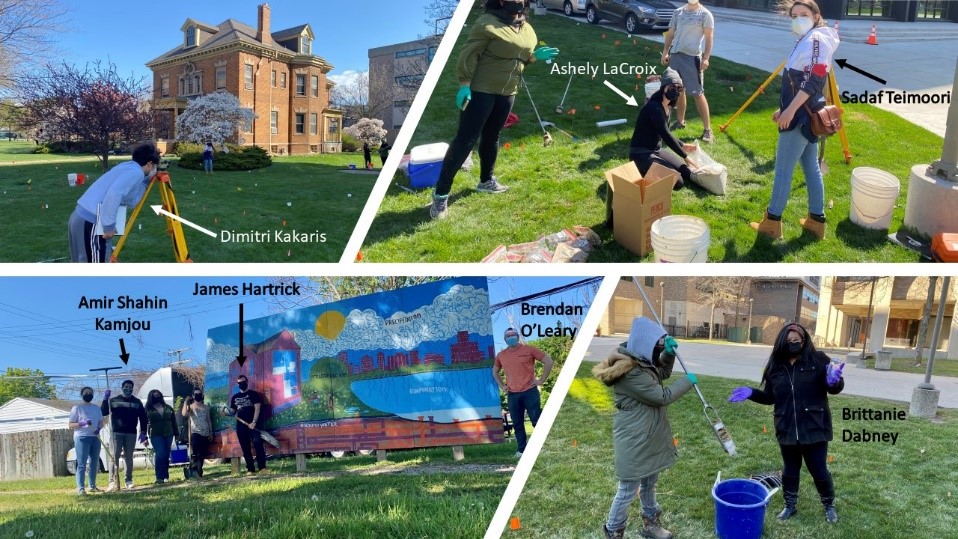
In addition to successfully implementing the project design, this project represents a successful collaboration of interdisciplinary undergraduate and graduate students from the departments of anthropology, biology, civil and environmental engineering, communication studies, and urban planning (Figure 2). Specific accomplishments are outlined in sections 2A, 2B, and 2C.
2A. Groundwater Flow and Modeling
- Hand auguring wells in disturbed urban soils with a shallow depth to GW proved economic and feasible at two residential-scale lots in Detroit, MI.
- Participants successfully used the free EPA 3PE tool to calculate GW flow vectors at both field sites.
- A simple urban water budget for each GSI location was calculated based on the GW monitoring wells and open-source USGS weather data.
- GMS-Modflow provided a visual for how green stormwater urban impacted GW depth (Figure 3).
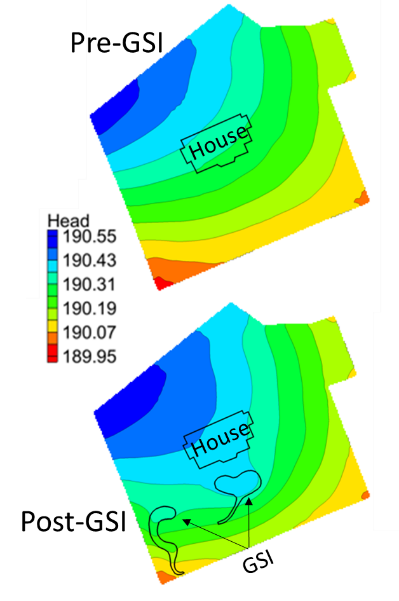
Figure 3: GMS modeled example of changes to urban groundwater with the addition of GSI.
2B. Groundwater and Soil Sampling
Figure 4 summarizes environmental considerations that direct our sampling approach, which is further described below.
- We used low-cost options for sampling and laboratory analyses to determine nitrogen, phosphorus, microbes, and microplastics at Linsell House and Hamilton Rainscape.
- The sampling approaches used in this study could be replicated in monitoring programs to understand how green stormwater infrastructure influences GW contamination.
- Compared with alternative methods, the methods for nutrients, coliforms, and microplastics were feasible.
- However, the alternative approaches we used may give researchers the information needed to determine the need to investigate contaminant concentrations with more quantitative or semi-quantitative methods.
- The Hach kits were most appropriate for GW and soil samples and offered a simple and reliable option. Spectrophotometer analysis was similar to Hach field kits data for most samples; however, turbidity greatly overestimated the absorbance for some samples.
- The m-ColiBlue24 tests for total coliforms/ Escherichia coli and m-EL agar for enterococci were effective; however, Petrifilm by 3M may provide a useful alternative to determine the presence or absence of coliforms. The concentration of enterococci was lower than e. coli; however, for groups where supplies and time are limited, the enterococci test should not be a priority as opposed to testing for total coliforms and e. coli.
- Microplastics in most GW wells increased during the study. In soils, extracting plastics with sodium chloride may be useful in understanding general trends; however, the more expensive salt sodium iodide extracted more plastics from soils.
- We recommend methods for determining microplastics should be modified depending on the slot size of the well screen and materials used during the study.
- Our sampling approach and recommendations can provide a framework for future researchers to implement when monitoring GW contaminants.
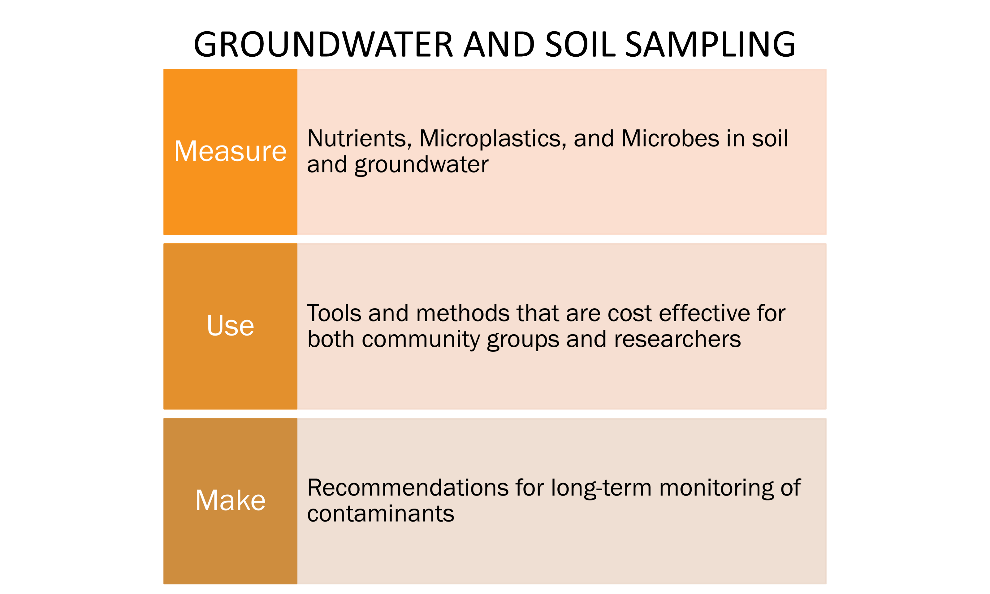
2C. Community Engagement
- Participants built two example GSI, a raingarden and bioswale, at the new WSU STEM building for community outreach (Figure 3 Post-GSI). This location is part of the P3 GW monitoring design, equipped with outdoor educational materials, and centrally located on-campus to showcase GSI to the WSU community.
- Participants hosted community members for GSI tours during the 2021 Great Lakes Bioneers Conference, engaged with community members at the Water Stewardship: Hamilton Rainscape, and presented project outcomes at the 2022 Joint Aquatic Sciences Meeting.
- Multiple classes (Biology Department, Communication Department, Civil and Environmental Engineering Department) engaged with the WSU P3 project to construct communication tools and quantitative assessments for the WSU P3 project. The communication tools (Figure 5) were provided to participating community groups and distributed during community outreach events (e.g., WSU GSI tours).
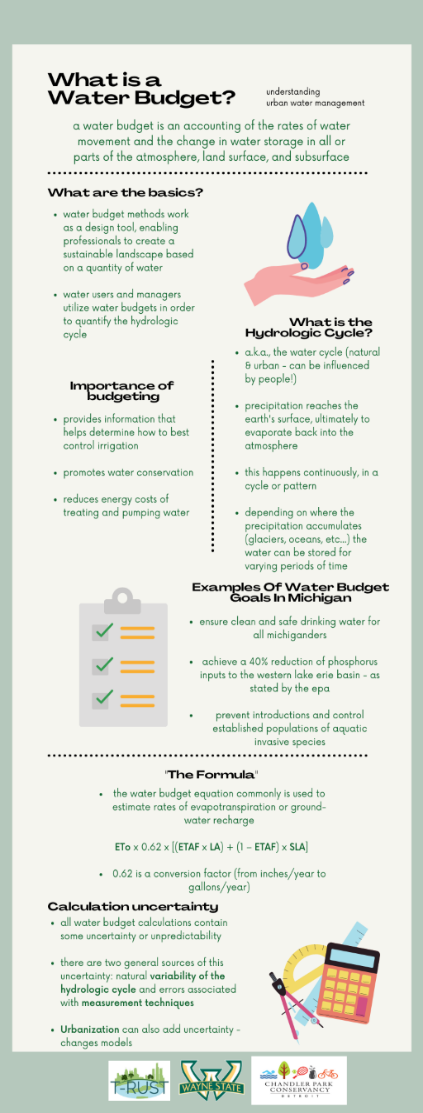
Figure 5: Example educational material generated by WSU community.
3. Conclusions and future perspectives
This project presents an adaptive and cost-effective way for urban community groups to assess the impact of GSI on neighborhood-scale GW quantity and quality. Urban GW is often an out-of-sight, out-of-mind resource that can directly impact urban health. The project furthers the EPA goals of Safe and Sustainable Water Resources by providing methods to assess this resource. Participants are currently developing a manuscript based on this project for publication.
References:
Bach, P. M., Rauch, W., Mikkelsen, P. S., McCarthy, D. T., & Deletic, A. (2014). A critical review of integrated urban water modelling Urban drainage and beyond. Environmental Modelling & Software, 54, 88107. https://doi.org/https://doi.org/10.1016/j.envsoft.2013.12.018
Claessens, L., Hopkinson, C., Rastetter, E., & Vallino, J. (2006). Effect of historical changes in land use and climate on the water budget of an urbanizing watershed. Water Resources Research, 42(3). https://doi.org/10.1029/2005WR004131
Gessner, M. O., Hinkelmann, R., Nützmann, G., Jekel, M., Singer, G., Lewandowski, J., et al. (2014). Urban water interfaces. Journal of Hydrology, 514, 226232. https://doi.org/https://doi.org/10.1016/j.jhydrol.2014.04.021
Grannemann, N G; R.J. Hunt, J.R. Nicholas, T.E. Reilly, and T. C. W. (2000). The importance of ground water in the Great Lakes region. US Department of the Interior, US Geological Survey.
Mozola, A. J. (1969). Geology for land and ground-water development in Wayne County, Michigan. Michigan Geological Survey.
Rogers, D. T. (1996). Environmental geology of metropolitan Detroit. Clayton Environmental Consultants.
Shaad, K., & Burlando, P. (2019). Monitoring and modelling of shallow groundwater dynamics in urban context: The case study of Jakarta. Journal of Hydrology, 573, 10461056. https://doi.org/https://doi.org/10.1016/j.jhydrol.2018.01.005
Teimoori, S., O'Leary, B. F., & Miller, C. J. (2021). Modeling Shallow Urban Groundwater at Regional and Local Scales: A Case Study in Detroit, MI. Water . https://doi.org/10.3390/w13111515
Thomas, M. A. (2000). The effect of residential development on ground-water quality near Detroit, Michigan 1. JAWRA Journal of the American Water Resources Association, 36(5), 10231038.
Warner, K. L., Ayotte, J. D., & Survey, U. S. G. (2015). The quality of our Nation's waters: water quality in the glacial aquifer system, northern United States, 1993-2009. Circular. Reston, VA. https://doi.org/10.3133/cir1352
Yu, L., Rozemeijer, J. C., van der Velde, Y., van Breukelen, B. M., Ouboter, M., & Broers, H. P. (2019). Urban hydrogeology: Transport routes and mixing of water and solutes in a groundwater influenced urban lowland catchment. Science of The Total Environment, 678, 288300. https://doi.org/https://doi.org/10.1016/j.scitotenv.2019.04.428